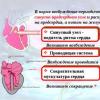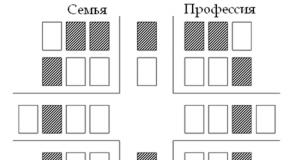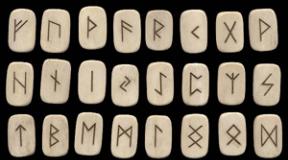Why is there a violation of the water-salt balance? Violations of the water-electrolyte balance What is the water-electrolyte balance of the body
Violation of the water-electrolyte balance in the body occurs in the following situations:
- With overhydration - excessive accumulation of water in the body and its slow release. The liquid medium begins to accumulate in the intercellular space and because of this, its level inside the cell begins to increase, and it swells. If overhydration activates nerve cells, then convulsions occur and nerve centers are excited.
- With dehydration - a lack of moisture or dehydration, the blood begins to thicken, blood clots form due to viscosity and blood flow to tissues and organs is disturbed. With its lack in the body over 20% of the body weight, death occurs.
It is manifested by a decrease in body weight, dryness of the skin, cornea. With a high level of deficiency, the skin can be collected in folds, the subcutaneous fatty tissue is similar in consistency to the dough, the eyes sink. The percentage of circulating blood also decreases, this is manifested in the following symptoms:
- facial features are sharpened;
- cyanosis of the lips and nail plates;
- hands and feet are cold;
- pressure decreases, pulse is weak and frequent;
- hypofunction of the kidneys, high level nitrogenous bases as a result of impaired protein metabolism;
- disruption of the heart, respiratory depression (according to Kussmaul), vomiting is possible.
Isotonic dehydration is often recorded - water and sodium are lost in equal proportions. A similar condition is common in acute poisoning - the required volume of fluid and electrolytes is lost during vomiting and diarrhea.
ICD-10 code
E87 Other disorders of water-salt and acid-base balance
Symptoms of imbalance in water and electrolyte balance
The first symptoms of a violation of the water-electrolyte balance depend on what pathological process occurs in the body (hydration, dehydration). This is increased thirst, and edema, vomiting, diarrhea. Changed acid-base balance, low blood pressure, irregular heartbeat. These signs cannot be neglected, as they lead to cardiac arrest and death if medical assistance is not provided on time.
With a lack of calcium in the blood, cramps of smooth muscles appear, a spasm of the larynx and large vessels is especially dangerous. With an increase in the content of Ca - pain in the stomach, thirst, vomiting, increased urination, inhibition of blood circulation.
Lack of K is manifested by atony, alkalosis, chronic renal failure, brain pathologies, intestinal obstruction, ventricular fibrillation and other changes in heart rhythm. An increase in potassium is manifested by ascending paralysis, nausea, and vomiting. The danger of this condition is that ventricular fibrillation and atrial arrest rapidly develop.
High Mg in the blood occurs with renal dysfunction, abuse of antacids. Nausea, vomiting appears, the temperature rises, heartbeat slows down.
Symptoms of a violation of the water-electrolyte balance indicate that the described conditions require immediate medical care to avoid even more serious complications and death.
Diagnostics of the violation of water-electrolyte balance
Diagnosis of imbalance in water and electrolyte balance at the initial admission is carried out approximately, further treatment depends on the body's response to the introduction of electrolytes, anti-shock drugs (depending on the severity of the condition).
The necessary information about a person and his state of health upon hospitalization is established by:
- History. During the survey (if the patient is conscious), data on the existing disorders of water-salt metabolism (peptic ulcer, diarrhea, narrowing of the gatekeeper, some forms of ulcerative colitis, severe intestinal infections, dehydration of a different etiology, ascites, diet low in salt).
- Establishing the degree of exacerbation of the current disease and further measures to eliminate complications.
- General, serological and bacteriological blood tests to identify and confirm the root cause of the current pathological condition. Also, additional instrumental and laboratory tests are prescribed to clarify the cause of the malaise.
Timely diagnosis of a violation of the water-electrolyte balance makes it possible to identify the severity of the violation as soon as possible and to organize the appropriate treatment in a timely manner.
Treatment of imbalance in water and electrolyte balance
Treatment of imbalance in water and electrolyte balance should take place according to the following scheme:
- Eliminate the likelihood of progressive development of a life-threatening condition:
- bleeding, acute blood loss;
- eliminate hypovolemia;
- eliminate hyper- or hypokalemia.
- Resume normal water-salt metabolism. Most often, to normalize water-salt metabolism, the following drugs are prescribed: NaCl 0.9%, glucose solution 5%, 10%, 20%, 40%, polyionic solutions (Ringer-Locke solution, lactasol, Hartman's solution, etc. .), erythrocyte mass, polyglucin, soda 4%, KCl 4%, CaCl2 10%, MgSO4 25%, etc.
- To prevent possible complications of an iatrogenic nature (epilepsy, heart failure, especially with the administration of sodium preparations).
- If necessary, in parallel with the intravenous administration of medicines, carry out diet therapy.
- With intravenous administration of saline solutions, it is necessary to control the level of VCO, CBS, control hemodynamics, and monitor renal function.
An important point - before the start intravenous administration salt components, it is necessary to calculate the probable loss of fluid and draw up a plan for restoring a normal VCO. The loss is calculated using the formulas:
Water (mmol) = 0.6 x Weight (kg) x (140 / Na true (mmol / L) + glucose / 2 (mmol / L)),
where 0.6 x Weight (kg) is the amount of water in the body
140 - average% Na (norm)
Na ist - true concentration of sodium.
Water deficit (l) = (Htst - HtN): (100 - HtN) x 0.2 x Weight (kg),
where 0.2 x Weight (kg) is the volume of extracellular fluid
HtN = 40 for females, 43 for males.
- Electrolyte content - 0.2 x Weight x (Norm (mmol / l) - true content (mmol / l).
Prevention of imbalance in water and electrolyte balance
Prevention of imbalance in the water-electrolyte balance consists in maintaining a normal water-salt balance. Salt metabolism can be disrupted not only in severe pathologies (3-4 degree burns, gastric ulcer, ulcerative colitis, acute blood loss, food intoxication, infectious diseases Gastrointestinal tract, mental disorders, accompanied by malnutrition - bulimia, anorexia, etc.), but also with excessive sweating, accompanied by overheating, systematic uncontrolled use of diuretics, prolonged salt-free diet.
V preventive purposes it is worth monitoring the state of health, controlling the course of existing diseases that can provoke a salt imbalance, not prescribing medications for yourself that affect the transit of fluid, replenishing the required daily fluid intake under conditions close to dehydration, and eating properly and balanced.
Prevention of imbalance in water and electrolyte balance also consists in correct diet- use oatmeal, bananas, chicken breast, carrots, nuts, dried apricots, figs, grape and orange juice is not only useful in itself, but also helps to maintain the correct balance of salts and trace elements.
Water makes up about 60% of the body weight of a healthy man (about 42 liters with a body weight of 70 kg). V female body the total amount of water is about 50%. Normal deviations from the mean values are approximately 15%, in both directions. Children have a higher water content than adults; gradually decreases with age.
Intracellular water makes up about 30-40% of body weight (about 28 liters in men with a body weight of 70 kg), being the main component of the intracellular space. Extracellular water makes up about 20% of body weight (about 14 liters). The extracellular fluid consists of interstitial water, which also includes the water of the ligaments and cartilage (about 15-16% of body weight, or 10.5 liters), plasma (about 4-5%, or 2.8 liters) and lymph and transcellular water (0.5-1% of body weight), usually not taking an active part in metabolic processes (cerebrospinal fluid, intra-articular fluid and contents of the gastrointestinal tract).
The aquatic environments of the body and osmolarity. The osmotic pressure of a solution can be expressed by the hydrostatic pressure that must be applied to the solution in order to keep it in bulk equilibrium with a simple solvent when the solution and solvent are separated by a membrane that is permeable only to the solvent. Osmotic pressure is determined by the number of particles dissolved in water and does not depend on their mass, size and valence.
The osmolarity of a solution, expressed in milliosmoles (mOsm), can be determined by the number of millimoles (but not milliequivalents) dissolved in 1 liter of water salts, plus the number of undissociated substances (glucose, urea) or weakly dissociated substances (protein). Osmolarity is determined using an osmometer.
The osmolarity of normal plasma is a fairly constant value and is equal to 285-295 mOsm. Of the total osmolarity, only 2 mOsm is due to proteins dissolved in plasma. Thus, sodium and chlorine ions dissolved in it (about 140 and 100 mOsm, respectively) are the main component of plasma that ensures its osmolarity.
It is believed that the intracellular and extracellular molar concentration should be the same, despite the qualitative differences in the ionic composition within the cell and in the extracellular space.
In accordance with the International System (SI), the amount of substances in a solution is usually expressed in millimoles per liter (mmol / l). The concept of "osmolarity", adopted in foreign and domestic literature, is equivalent to the concept of "molarity", or "molar concentration". The units "meq" are used when you want to reflect the electrical relationships in a solution; the unit "mmol" is used to express the molar concentration, that is, the total number of particles in solution, regardless of whether they carry an electric charge or are neutral; mOsm units are convenient for showing the osmotic strength of a solution. Essentially, the concepts "mOsm" and "mmol" are identical for biological solutions.
Electrolyte composition human body... Sodium is predominantly a cation of the extracellular fluid. Chlorides and bicarbonate represent the anionic electrolyte group of the extracellular space. In the cell space, the determining cation is potassium, and the anionic group is represented by phosphates, sulfates, proteins, organic acids and, to a lesser extent, bicarbonates.
Anions inside the cell are usually polyvalent and do not freely penetrate through the cell membrane. Potassium is the only cellular cation for which the cell membrane is permeable and which is in a free state in a sufficient amount.
Predominantly extracellular, sodium localization is due to its relatively low penetrating ability through the cell membrane and a special mechanism for displacing sodium from the cell - the so-called sodium pump. The chlorine anion is also an extracellular component, but its potential penetration through the cell membrane is relatively high; it is not realized mainly because the cell has a fairly constant composition of fixed cellular anions, which create a predominance of negative potential in it, displacing chlorides. The energy of the sodium pump is provided by the hydrolysis of adenosine triphosphate (ATP). This same energy promotes the movement of potassium into the cell.
Control elements for water and electrolyte balance. Normally, a person should consume as much water as is necessary to compensate for its daily loss through the kidneys and extrarenal routes. The optimal daily urine output is 1400-1600 ml. Under normal temperature conditions and normal air humidity, the body loses through the skin and Airways from 800 to 1000 ml of water - these are the so-called imperceptible losses. Thus, the total daily excretion of water (urine and perspiration loss) should be 2200-2600 ml. The body is able to partially cover its needs through the use of metabolic water formed in it, the volume of which is about 150-220 ml. The normal balanced daily human need for water is from 1000 to 2500 ml and depends on body weight, age, gender and other circumstances. In surgical and resuscitation practice, there are three options for determining urine output: daily urine collection (in the absence of complications and in mild patients), determination of urine output every 8 hours (in patients receiving any type of infusion therapy during the day) and determination of hourly urine output (in patients with severe disorder of water and electrolyte balance, in shock and suspected renal failure). Diuresis satisfactory for a seriously ill patient, ensuring the electrolyte balance of the body and complete elimination of toxins, should be 60 ml / h (1500 ± 500 ml / day).
Oliguria is considered to be urine output less than 25-30 ml / h (less than 500 ml / day). Currently, prerenal, renal and postrenal oliguria are distinguished. The first occurs as a result of a blockage of renal vessels or inadequate blood circulation, the second is associated with parenchymal renal failure and the third with impaired outflow of urine from the kidneys.
Clinical signs of imbalance in water balance. With frequent vomiting or diarrhea, a significant water-electrolyte imbalance should be expected. Thirst indicates that the patient's volume of water in the extracellular space is reduced relative to the content of salts in it. A patient with true thirst is able to quickly eliminate water shortages. The loss of clean water is possible in patients who cannot drink on their own (coma, etc.), as well as in patients who are sharply limited drinking without appropriate intravenous compensation. glucose in diabetic coma, the use of mannitol or urea).
Dryness in the armpits and groin areas is an important symptom of water loss and indicates that the body is deficient in water at least 1500 ml.
A decrease in tissue and skin turgor is considered as an indicator of a decrease in the volume of interstitial fluid and the body's need for the introduction of saline solutions (the need for sodium). The tongue in normal conditions has a single, more or less pronounced median longitudinal groove. With dehydration, additional grooves appear parallel to the median.
Body weight that changes over short periods of time (for example, after 1 to 2 hours) is an indicator of changes in extracellular fluid. However, these definitions of body weight should be interpreted only in a joint assessment with other indicators.
Changes in blood pressure and pulse are observed only with a significant loss of water by the body and are most associated with changes in the BCC. Tachycardia is a fairly early sign of decreased blood volume.
Edema always reflects an increase in the volume of interstitial fluid and indicates that the total amount of sodium in the body is increased. However, edema is not always a highly sensitive indicator of sodium balance, since the distribution of water between the vascular and interstitial spaces is normally due to a high protein gradient between these media. The appearance of a barely noticeable depression from pressure in the area of the anterior surface of the leg with a normal protein balance indicates that the body has an excess of at least 400 mmol of sodium, i.e., more than 2.5 liters of interstitial fluid.
Thirst, oliguria and hypernatremia are the main signs of water deficiency in the body.
Hypohydration is accompanied by a decrease in CVP, which in some cases becomes negative. V clinical practice Normal CVP numbers are considered to be 60-120 mm of water. Art. With water overload (overhydration), CVP values can significantly exceed these figures. However, excessive use of crystalloid solutions can sometimes be accompanied by water overload of the interstitial space (including interstitial pulmonary edema) without a significant increase in CVP.
Loss of fluid and pathological movement of it in the body. External losses of fluid and electrolytes can occur with polyuria, diarrhea, excessive sweating, as well as with profuse vomiting, through various surgical drains and fistulas, or from the surface of wounds and burns of the skin. Internal movement of fluid is possible with the development of edema in the injured and infected areas, but it is mainly due to a change in the osmolarity of fluid media - the accumulation of fluid in the pleural and abdominal cavity with pleurisy and peritonitis, blood loss in the tissue with extensive fractures, the movement of plasma into injured tissues with crush syndrome, burns or to the wound area.
A special type of internal fluid movement is the formation of so-called transcellular pools in gastrointestinal tract(intestinal obstruction, intestinal infarction, severe postoperative paresis).
The area of the human body where fluid is temporarily moved is called the “third space” (the first two spaces are the cellular and extracellular water sectors). This movement of fluid, as a rule, does not cause significant changes in body weight. Internal sequestration of fluid develops within 36-48 hours after surgery or after the onset of the disease and coincides with the maximum metabolic and endocrine changes in the body. Then the process begins to slowly regress.
Disorder of water and electrolyte balance. Dehydration. There are three main types of dehydration: water depletion, acute dehydration, and chronic dehydration.
Dehydration due to the primary loss of water (water depletion) occurs as a result of an intense loss of pure water or liquid with a low salt content, i.e. hypotonic, for example, with fever and shortness of breath, with prolonged artificial ventilation lungs through a tracheostomy without adequate moistening of the respiratory mixture, with profuse pathological sweating during fever, with an elementary restriction of water intake in patients in coma and critical conditions, as well as as a result of the separation of large amounts of weakly concentrated urine with no diabetes mellitus... Clinically characterized by severe general condition, oliguria (in the absence of diabetes insipidus), increasing hyperthermia, azotemia, disorientation turning into a coma, sometimes convulsions. Thirst appears when water loss reaches 2% of body weight.
An increase in the concentration of electrolytes in the plasma and an increase in plasma osmolarity are detected in the laboratory. The sodium concentration in plasma rises to 160 mmol / L or more. The hematocrit also rises.
Treatment consists in the introduction of water in the form of an isotonic (5%) glucose solution. When treating all variants of disorders of water and electrolyte balances using various solutions, they are administered only intravenously.
Acute dehydration as a result of loss of extracellular fluid occurs with acute obstruction of the pylorus, small bowel fistula, ulcerative colitis, as well as with high small bowel obstruction and other conditions. All the symptoms of dehydration, prostration and coma are observed, the initial oliguria is replaced by anuria, hypotension progresses, hypovolemic shock develops.
Signs of some thickening of the blood are determined in a laboratory, especially in the later stages. Plasma volume decreases slightly, plasma protein content, hematocrit and, in some cases, plasma potassium content increase; more often, however, hypokalemia develops rapidly. If the patient does not receive specific infusion treatment, the plasma sodium content remains normal. With the loss of a large amount of gastric juice (for example, with repeated vomiting), a decrease in the level of plasma chlorides is observed with a compensatory increase in the content of bicarbonate and the inevitable development of metabolic alkalosis.
Lost fluid must be quickly replaced. The basis of the transfused solutions should be isotonic saline solutions. With a compensatory excess in the plasma of HC0 3 (alkalosis), an isotonic glucose solution with the addition of proteins (albumin or protein) is considered an ideal replacement solution. If the cause of dehydration was diarrhea or small intestinal fistula, then, obviously, the content of HCO 3 in the plasma will be low or close to normal and the liquid for replacement should consist of 2/3 of isotonic sodium chloride solution and 1/3 of a 4.5% solution sodium bicarbonate. The administration of a 1% solution of KO is added to the therapy, up to 8 g of potassium (only after the restoration of diuresis) and an isotonic glucose solution of 500 ml every 6-8 hours are added.
Chronic dehydration with loss of electrolytes (chronic electrolyte deficiency) occurs as a result of the transition of acute dehydration with loss of electrolytes into the chronic phase and is characterized by general dilutional hypotension of the extracellular fluid and plasma. Clinically characterized by oliguria, general weakness, and sometimes an increase in body temperature. Thirst is almost never thirsty. A low sodium content in the blood is determined in a laboratory with a normal or slightly elevated hematocrit. Plasma potassium and chloride levels tend to decrease, especially with prolonged loss of electrolytes and water, for example from the gastrointestinal tract.
Treatment with hypertonic sodium chloride solutions is aimed at eliminating the electrolyte deficiency in the extracellular fluid, eliminating extracellular fluid hypotension, restoring the osmolarity of plasma and interstitial fluid. Sodium bicarbonate is prescribed only for metabolic acidosis. After restoration of plasma osmolarity, 1% KC1 solution is injected up to 2-5 g / day.
Extracellular salt hypertension due to salt overload occurs as a result of excessive introduction of salt or protein solutions into the body with a lack of water. Most often develops in patients with tube or tube feeding, who are in an inadequate or unconscious state. Hemodynamics remains intact for a long time, diuresis remains normal, in some cases moderate polyuria (hyperosmolarity) is possible. There is a high level of sodium in the blood with a stable normal diuresis, a decrease in hematocrit and an increase in the level of crystalloids. The relative density of urine is normal or slightly increased.
Treatment consists of limiting the amount of salt administered and the introduction of additional water by mouth (if possible) or parenterally in the form of a 5% glucose solution while reducing the volume of tube or tube feeding.
Primary excess of water (water intoxication) becomes possible with the erroneous introduction into the body of excess amounts of water (in the form of an isotonic solution of glucose) under conditions of limited diuresis, as well as with excessive introduction of water through the mouth or with repeated irrigation of the large intestine. Patients develop drowsiness, general weakness, diuresis decreases, coma and convulsions occur in later stages. Plasma hyponatremia and hypoosmolarity are determined in the laboratory, but natriuresis remains normal for a long time. It is generally accepted that with a decrease in sodium content to 135 mmol / L in plasma, there is a moderate excess of water relative to electrolytes. The main danger of water intoxication is swelling and edema of the brain and subsequent hypoosmolar coma.
Treatment begins with a complete cessation of water therapy. With water intoxication without deficiency total sodium forced diuresis is prescribed in the body with the help of saluretics. In the absence of pulmonary edema and normal CVP, a 3% NaCl solution is injected up to 300 ml.
Electrolyte metabolism pathology. Hyponatremia (plasma sodium content below 135 mmol / L). 1. Severe diseases occurring with delayed diuresis (cancer processes, chronic infection, decompensated heart disease with ascites and edema, liver disease, chronic starvation).
2. Post-traumatic and postoperative conditions (trauma to the bone skeleton and soft tissues, burns, postoperative sequestration of fluids).
3. Loss of sodium by the non-renal route (repeated vomiting, diarrhea, the formation of a "third space" in acute intestinal obstruction, small bowel fistulas, profuse sweating).
4. Uncontrolled use of diuretics.
Since hyponatremia is almost always a condition secondary to the main pathological process, there is no unequivocal treatment for it. Hyponatremia caused by diarrhea, repeated vomiting, small bowel fistula, acute intestinal obstruction, postoperative fluid sequestration, as well as forced diuresis, it is advisable to treat using sodium-containing solutions and, in particular, isotonic sodium chloride solution; in case of hyponatremia, which developed in conditions of decompensated heart disease, the introduction of additional sodium into the body is inappropriate.
Hypernatremia (plasma sodium content above 150 mmol / L). 1. Dehydration with water depletion. An excess of every 3 mmol / L sodium in plasma in excess of 145 mmol / L means a deficiency of 1 L of extracellular water K.
2. Salt overload of the body.
3. Diabetes insipidus.
Hypokalemia (potassium content below 3.5 mmol / l).
1. Loss of gastrointestinal fluid followed by metabolic alkalosis. The concomitant loss of chloride deepens the metabolic alkalosis.
2. Long-term treatment with osmotic diuretics or saluretics (mannitol, urea, furosemide).
3. Stressful conditions with increased adrenal activity.
4. Restriction of potassium intake in the postoperative and post-traumatic periods in combination with sodium retention in the body (iatrogenic hypokalemia).
With hypokalemia, a potassium chloride solution is administered, the concentration of which should not exceed 40 mmol / l. 1 g of potassium chloride, from which a solution for intravenous administration is prepared, contains 13.6 mmol of potassium. The daily therapeutic dose is 60-120 mmol; according to indications, large doses are also used.
Hyperkalemia (potassium content above 5.5 mmol / l).
1. Acute or chronic renal failure.
2. Acute dehydration.
3. Major injuries, burns or major operations.
4. Severe metabolic acidosis and shock.
A potassium level of 7 mmol / L poses a serious threat to the patient's life due to the risk of cardiac arrest due to hyperkalemia.
With hyperkalemia, the following sequence of measures is possible and advisable.
1. Lasix IV (from 240 to 1000 mg). A daily urine output of 1 liter is considered satisfactory (at normal relative urine density).
2. 10% glucose solution IV (about 1 L) with insulin (1 U per 4 g of glucose).
3. To eliminate acidosis - about 40-50 mmol of sodium bicarbonate (about 3.5 g) in 200 ml of 5% glucose solution; in the absence of effect, another 100 mmol is introduced.
4. Calcium gluconate IV to reduce the effect of hyperkalemia on the heart.
5. In the absence of effect from conservative measures, hemodialysis is indicated.
Hypercalcemia (plasma calcium levels greater than 11 mg%, or more than 2.75 mmol / L on repeated examinations) usually occurs with hyperparathyroidism or with metastasis of cancer to bone tissue. Special treatment.
Hypocalcemia (plasma calcium levels below 8.5%, or less than 2.1 mmol / L), is observed with hypoparathyroidism, hypoproteinemia, acute and chronic renal failure, with hypoxic acidosis, acute pancreatitis, as well as with a deficiency of magnesium in the body. Treatment is intravenous calcium supplementation.
Hypochloremia (plasma chlorides below 98 mmol / l).
1. Plasmodilution with an increase in the volume of the extracellular space, accompanied by hyponatremia in patients with severe diseases, with water retention in the body. In some cases, hemodialysis with ultrafiltration is indicated.
2. Loss of chlorides through the stomach with repeated vomiting, as well as with intense loss of salts at other levels without appropriate compensation. Usually combined with hyponatremia and hypokalemia. Treatment is the introduction of chlorine-containing salts, mainly KCl.
3. Uncontrolled diuretic therapy. Combines with hyponatremia. Treatment is with discontinuation of diuretic therapy and salt replacement.
4. Hypokalemic metabolic alkalosis. Treatment - intravenous administration of KCl solutions.
Hyperchloremia (plasma chlorides above 110 mmol / L), observed with water depletion, diabetes insipidus and damage to the brainstem (combined with hypernatremia), as well as after ureterosigmostomy due to increased reabsorption of chlorine in the colon. Special treatment.
What causes an imbalance in the water-salt balance in the body, and what consequences can this imbalance cause?
Two phenomena - one problem
The water-electrolyte (water-salt) balance can be disturbed in two directions:
- Overhydration- excessive accumulation of fluid in the body, slowing down the excretion of the latter. It accumulates in the intercellular space, its level inside the cells increases, the latter swell. When nerve cells are involved in the process, nerve centers are excited and convulsions occur;
- Dehydration is the opposite of the previous one. The blood begins to thicken, the risk of blood clots increases, and blood flow in tissues and organs is disrupted. With a deficit of more than 20%, death occurs.
Violation of the water-salt balance is manifested by weight loss, dry skin and cornea. With a strong deficiency of moisture, the subcutaneous fatty tissue resembles dough in consistency, the eyes sink, the volume of circulating blood decreases.
Dehydration is accompanied by an exacerbation of facial features, cyanosis of the lips and nails, reduced pressure, weak and frequent pulse, kidney hypofunction, increased concentration of nitrogenous bases due to impaired protein metabolism. Also, a person's upper and lower extremities are freezing.
There is such a diagnosis as isotonic dehydration - the loss of water and sodium in equal amounts. This happens in acute poisoning, when electrolytes and the volume of the liquid medium are lost during diarrhea and vomiting.
Why there is a lack or excess of water in the body
The main causes of pathology are external fluid loss and redistribution of water in the body. The level of calcium in the blood decreases:
- with pathologies thyroid gland or after removing it;
- when drugs are used radioactive iodine(for treatment);
- with pseudohypoparathyroidism.
Sodium decreases with long-term current diseases, accompanied by a decrease in urine output; v postoperative period; with self-medication and uncontrolled intake of diuretics.
- Potassium decreases as a result of its intracellular movement;
- With alkalosis;
- Aldosteronism;
- Corticosteroid therapy;
- Alcoholism;
- Liver pathologies;
- After operations on the small intestine;
- With insulin injections;
- Hypofunction of the thyroid.
The reason for its increase is an increase in catitones and a delay in its compounds, damage to cells and the release of potassium from them.
Symptoms and signs of water-salt imbalance
The first warning signs depend on what is happening in the body - overhydration or dehydration. This includes:
- swelling;
- vomit;
- diarrhea;
- intense thirst.
- Acid-base balance often changes, decreases blood pressure, there is an arrhythmic heartbeat... These symptoms cannot be ignored, as progressive pathology leads to cardiac arrest and death.
- Calcium deficiency leads to smooth muscle cramps... Spasm of large vessels and larynx is especially dangerous. With an excess of this element, pain in the stomach, severe thirst, vomiting, frequent urination, poor blood circulation occurs.
- Potassium deficiency is accompanied by alkalosis, atony, chronic renal failure, intestinal obstruction, brain pathologies, ventricular fibrillation of the heart and other changes in its rhythm.
- With an increase in its concentration in the body, ascending paralysis occurs, nausea, vomiting. This condition is very dangerous, since fibrillation of the heart ventricles develops very quickly, that is, there is a high probability of atrial arrest.
- Excess magnesium occurs with antacid abuse and kidney dysfunction. This condition is accompanied by nausea, up to vomiting, elevated temperature slowing down the heart rate.
The role of the kidneys and urinary system in the regulation of water-salt balance
The function of this paired organ is aimed at maintaining the constancy of various processes. They answer:
- for ion exchange occurring on both sides of the tubular membrane;
- elimination of excess cations and anions from the body by adequate reabsorption and excretion of potassium, sodium and water.
The role of the kidneys is very important, since their functions allow maintaining a stable volume of intercellular fluid and the optimal level of substances dissolved in it.
Per day healthy person you need about 2.5 liters of liquid. He receives about 2 liters through food and drink, 1/2 liter is formed in the body itself as a result metabolic processes... One and a half liters are excreted by the kidneys, 100 ml - by the intestines, 900 ml - by the skin and lungs.
The amount of fluid that the kidneys excrete depends on the condition and needs of the body itself. With maximum diuresis, this organ of the urinary system can excrete up to 15 liters of fluid, and with antidiuresis - up to 250 ml.
Sharp fluctuations in these indicators depend on the intensity and nature of tubular reabsorption.
Diagnostics of violations of water-salt balance
At the initial examination, a presumptive conclusion is made, further therapy depends on the patient's response to the introduction of anti-shock agents and electrolytes.
The doctor makes a diagnosis based on the patient's complaints, history, research results:
- Anamnesis. If the patient is conscious, his survey is carried out, information about violations of the water-electrolyte balance (diarrhea, ascites, peptic ulcer, narrowing of the pylorus, severe intestinal infections, some types of ulcerative colitis, dehydration of various etiologies, short-term diets with a low salt content in the menu) ;
- Setting the degree of pathology, taking measures to eliminate and prevent complications;
- General, bacteriological and serological blood tests to identify the cause of the rejection. Additional laboratory and instrumental studies may be assigned.
Modern diagnostic methods make it possible to establish the cause of the pathology, its degree, as well as to begin in a timely manner to relieve symptoms and restore human health.
How can you restore the water-salt balance in the body?
Therapy involves the following activities:
- Conditions that can become a threat to life are stopped;
- Bleeding and acute blood loss are eliminated;
- Hypovolemia is eliminated;
- Hyper- or hyperkalemia is eliminated;
- It is necessary to apply measures to regulate normal water-electrolyte metabolism. Most often, a glucose solution, polyionic solutions (Hartmann, lactasol, Ringer-Locke), erythrocyte mass, polyglucin, soda are prescribed;
- You also need to prevent the development possible complications- epilepsy, heart failure, in particular during therapy with sodium preparations;
- During recovery with the help of intravenous administration of saline solutions, it is necessary to control hemodynamics, renal function, the level of CBS, VCO.
Preparations used to restore water-salt balance
- Potassium and magnesium asparaginate- required for myocardial infarction, heart failure, artimia, hypokalemia and hypomagnesemia. The drug is well absorbed when taken orally, excreted by the kidneys, transfers magnesium and potassium ions, and promotes their entry into the intercellular space.
- Sodium bicarbonate- often used for peptic ulcer, gastritis with high acidity, acidosis (with intoxication, infection, diabetes mellitus), as well as with kidney stones, inflammation of the respiratory system and oral cavity.
- Sodium chloride - used in case of a lack of intercellular fluid or its large loss, for example, with toxic dyspepsia, cholera, diarrhea, indomitable vomiting, severe burns. The drug has a rehydrating and detoxifying effect, allows you to restore water-electrolyte metabolism in various pathologies.
- Sodium citrate - allows you to restore normal performance blood. This product increases the concentration of sodium.
- Hydroxyethyl starch (ReoHES)- the agent is used for surgical interventions, acute blood loss, burns, infections as a prophylaxis of shock and hypovolemia. It is also used for deviating microcirculation, as it promotes the diffusion of oxygen throughout the body, restores the walls of the capillaries.
Maintaining the natural water-salt balance
This parameter can be violated not only with serious pathologies, but also with profuse sweating, overheating, uncontrolled use of diuretics, long-term salt-free diet.
The drugs in this group include crystalloid (polyionic solutions) and osmotic diuretics:
Crystalloid solutions
The following solutions are most commonly used:
Physiological (isotonic) solution
sodium chloride - 0.9% solution
Ringer's solution
sodium chloride - 8.0 g
potassium chloride - 0.075 g
calcium chloride - 0.1 g
sodium bicarbonate - 0.1 g
Ringer-Locke solution
sodium chloride - 9.0 g
potassium chloride - 0.2 g
calcium chloride - 0.2 g
sodium bicarbonate - 0.2 g
glucose - 1.0 g
bidistilled water - up to 1 l
Lactasol
sodium chloride - 6.2 g
potassium chloride - 0.3 g
calcium chloride - 0.16 g
magnesium chloride - 0.1 g
sodium lactate - 3.36 g
sodium bicarbonate - 0.3 g
distilled water - up to 1 l
In clinical practice, these solutions are used to correct water-salt balance, they contain the most adequate set of ions for the blood composition. And solutions like Ringer-Locke and lactosol also contain anti-acidotic components in the form of sodium bicarbonate or sodium lactate. To correct acidosis, intravenous infusion is performed 4-5% sodium bicarbonate solution (soda).
Polyionic solutions have a low molecular weight and quickly penetrate through the capillary wall into the intercellular space, restoring the fluid deficit in the interstitium. They leave the vascular bed rather quickly. In this regard, it is advisable to combine the use of crystalloid and colloidal solutions.
Crystalloids, along with hemodynamic colloidal blood substitutes, are included in the complex therapy of traumatic and hemorrhagic shock, purulent-septic diseases, and are also used for the prevention and correction of violations of the water-salt balance and acid-base balance of blood during major operations and in the postoperative period. In this case, not only the deficiency of extracellular fluid is replenished, metabolic acidosis is compensated and detoxified, but some hemodynamic one also occurs, which consists in partial correction of hypovolemia and stabilization of blood pressure.
Infiltration and conduction anesthesia
Infiltration: It combines the positive qualities of infiltration and conduction anesthesia.
Anatomically, the method is based on the structural features of fascial formations. An anesthetic solution, injected under pressure into these cases, spreads into them and penetrates to the nerves and nerve endings. Tight novocaine infiltrations move (crawl) along the cases and merge with each other. A.A. Vishnevsky called his method of anesthesia the creeping infiltrate method.
Anesthesia is carried out by the surgeon during the operation, using alternately a syringe and a scalpel as the tissue layer is dissected.
Infiltration of tissues must be carried out before opening the case, since if the case is cut or accidentally damaged, the solution of the anesthetic substance will pour into the wound and it will be impossible to create a dense creeping infiltrate. Consequently, it is not possible to achieve a sufficient analgesic effect under these conditions. Tight infiltration of tissues with an anesthetic solution carries out hydraulic dissection of tissues, vessels and nerves are easily identified in the infiltrate, which avoids their damage, and it is easy to stop bleeding. For infiltration anesthesia, use a 0.25% solution of novocaine with the addition of adrenaline (3 drops of 1: 1000 adrenaline solution per 100 ml of novocaine solution). For case anesthesia, a large amount of solution is consumed (up to 800 and even 1000 ml), but due to the low concentration of the anesthetic and the solution flowing into the wound when the cases are opened during the operation, intoxication does not occur.
For anesthesia, two syringes are used (2 and 5 ml or 5 and 10 ml).
1. To anesthetize the skin, an anesthetic solution is injected with a thin needle intradermally, creating a nodule in the form of a "lemon peel" along the entire line of skin incision. Each injection is made at the edge of the nodule formed by the previous injection.
2. Novocaine is injected into the subcutaneous tissue through the infiltrated skin. Sufficient infiltration of the subcutaneous tissue is determined by raising the entire incision area in the form of a roller.
3. After dissection of the skin and subcutaneous tissue, the anesthetic solution is injected into the deep-lying tissues, infiltrating the muscles, and then under the muscles in the upward, downward and sideways directions.
When dissecting the muscles, additional infiltration of the tissues with anesthetic solution is performed.
Conductor: There are the following types of conduction anesthesia: anesthesia of the nerve trunks, anesthesia nerve plexuses, anesthesia of nerve nodes (paravertebral), spinal and epidural (epidural) anesthesia. The anesthetic is administered peri - or endoneurally.
Finger conduction anesthesia according to Lukashevich - Oberst it is used for finger operations (for panaritiums, wounds). A tourniquet is applied to the base of the finger, distally from the lateral surfaces of the main phalanx, the skin and subcutaneous tissue are anesthetized, and then the needle is advanced to the bone. After that, it is first moved to one side of the bony phalanx and introduced in the immediate vicinity of the nerves of the finger, which pass along its lateral surface.
Kulenkampf brachial plexus anesthesia used in operations on the surface of the limb. The position of the patient on his back, the head is turned in the opposite direction, the hand hangs freely from the table. In the middle of the clavicle, along the upper edge of it, the projection of the subclavian artery is determined. The brachial plexus is projected outward from the subclavian artery. After infiltration of the skin with a solution of novocaine, a long needle without a syringe is inserted outward from the place of pulsation of the artery 1 cm above the clavicle and, sliding along the upper edge of the I rib, is advanced upwards in the direction of the spinous processes of the I and II thoracic vertebrae and reach the plexus. The appearance of discomfort in the hand, a feeling of numbness or a sensation of "shooting" pain indicates the meeting of the needle with one of the nerve trunks of the plexus. The release of blood from the needle indicates that it has entered the vessel. In such cases, the needle is somewhat pulled back and the direction of its stroke is changed. After making sure that no blood is released from the needle, 30-35 ml of 1% lidocaine solution is injected. Anesthesia occurs in 10-15 minutes and lasts for 2-6 hours.
Retromammary blockade It is used to treat mastitis in the serous and infiltrative stages. At the same time, 0.25% is introduced into the retromammary fiber. solution of novocaine in a volume of 150-200 ml with an antibiotic (enzyme preparation).
Intercostal anesthesia used for fractured ribs. Having retreated a few centimeters from the place of the rib fracture towards the spine, the skin is anesthetized by intradermal injection of a solution of novocaine from a syringe with a needle. A needle is inserted perpendicular to the broken rib at the site of skin anesthesia, Novocaine is slowly injected if it is damaged all the way into the rib. Pulling the needle back by 2-3 mm, move its end soft tissue, the needle is advanced to the lower edge of the rib, sliding along its surface, and 3-5 ml of 1-2% novocaine solution is injected perineurally. Without removing the needle, return it to the outer surface of the rib, advance it by sliding to the upper edge of the same rib and inject 2-3 ml of 1-2% novocaine solution, after which the needle is removed. If several ribs are broken, the procedure is repeated.
Short penicillin-novocaine block:
Indications: Used for limited inflammatory processes (boil, inflammatory infiltrate, etc.)
Technique: Around the inflammatory focus, departing from its visible border, novocaine with an antibiotic is injected into the subcutaneous tissue from different points, creating also a pillow under the focus. Usually, 40-60 ml of 0.25% solution of novocaine is injected.
The water-salt balance is the quantitative ratio between the volume of liquid and salts that has entered the body and the excreted components. If this balance is not disturbed, the person feels cheerful. In case of violation, a corresponding symptom complex arises, which gives a person a certain discomfort.
The water-salt balance characterizes the penetration and removal of salt and liquid from the body, as well as the nature of their digestibility, ingestion into each internal organ and the system.
More than 50% of the contents of the human body are water. The volume of fluid differs from person to person based on body weight, age, and other factors. According to research data, an infant born into the world consists of water by 77%, an adult man by 60-61%, a woman by 54-55%. If we compare the elements - blood, intercellular fluid and water in tissues. The latter has the highest concentration of elements such as magnesium, potassium, phosphates, insufficient such as calcium, sodium, chlorine. This difference is provided by low level permeability of capillary walls for protein.
It is important for the body to maintain water balance
If a violation of the water-salt balance does not occur, this contributes to the maintenance of the normal quantitative content of beneficial trace elements and a constant water level.
The importance of balance in the body
Water, ions and electrolytes are excreted with the help of the kidneys, which is ensured under control nervous system and some hormones endocrine system... The normal daily volume of fluid consumed is 2-2.5 liters. The same volume also leaves the body through the activity of the kidneys, intestines, skin, lungs.
Constant monitoring of the normal quantitative content of salts in the body is the guarantee of its health, of each organ and system. The presence of salts is observed in every cell and fluid, including plasma. If the water-salt balance is disturbed, it causes a malfunction in the functioning of the whole organism.
Signs and causes of violation
The provoking factors that contribute to a malfunction in the water-salt balance in humans are different. Among the most common are the following:
- Profuse bleeding. It causes a decrease in blood volume and compensation for lost elements, causing an increase in the volume of salts and fluid.
- Prolonged unconsciousness, and the body does not receive a normal volume of water.
- Development of renal failure. The disease causes an increase in the volume of fluid, the concentration of salts in the bloodstream, causing impaired cellular functioning.
- Abuse of foods containing salt, the development of kidney stones cause a malfunction in the functioning of the urinary system.
- Frequent vomiting, increased sweating, diarrhea - those pathologies that cause a decrease in the quantitative volume of salt and loss of water through the epidermis.
- Long-term and uncontrolled therapy with diuretic drugs also contributes to imbalance.
- Increased vascular permeability contributes to an increase in salt and fluid content, as well as a failure in the process of their excretion.
The initial symptoms of an imbalance in the water-salt balance in the body vary, taking into account whether there is an insufficient volume of salt and water or their excess is observed. To general clinical manifestations include:
- swelling of the limbs;
- loose stools;
- constant desire to drink;
- lowering blood pressure;
- arrhythmia in the heartbeat.
In the presence of such a symptom complex, you need to see a doctor and not rely on self-healing. If medical measures are not taken in time, complications arise, up to cardiac arrest and death.

Lack of salt leads to serious consequences
With an insufficient content in a person of such an element as calcium, convulsive syndrome occurs in relation to smooth muscles. Cramps in the laryngeal vessels are especially dangerous. If there is an excessive amount of calcium, there is pain in the epigastrium, gag reflex, increased urination, and a failure in the blood flow.
If there is an insufficient amount of potassium, atony, alkalosis, chronic insufficiency kidney, intestinal obstruction, impaired functioning of the brain, heart. Exceeding this volume causes ascending paralysis, nausea and vomiting syndrome.
With a magnesium deficiency, nausea-vomiting syndrome, an increase in overall temperature, and a decrease in heart rate are observed.
Recovery methods
How to establish a water-salt balance is determined taking into account the degree of manifestation of unpleasant symptoms, the level of excess or insufficient content of a certain element.
Diet
Correction of the water-salt balance in the body is based not only on therapy drugs but also compliance proper nutrition... Dietary recommendations are indicated by the attending physician based on the characteristics of the development of pathology.
Control of consumed salt is mandatory. The daily volume of such is not more than 7 g. In some cases, it is completely excluded from the diet. A large amount of seasoning is included in convenience foods, fast food, so they are not consumed. It is advisable to use salt with iodine in the composition or sea salt instead of the usual table salt.
It is also important to regulate the fluid intake. The daily rate is 2-2.5 liters.
A larger volume of fluid should be drunk in the first 6 hours after waking up in order to avoid the occurrence of puffiness at night.
Medication method
Preparations for restoring water-salt balance are vitamin complexes, rich in those useful microelements contained in insufficient amounts. Those are developed with sodium, calcium, magnesium in the composition.
Medicines Vitrum, Duovit, Complivit are often prescribed. The duration of therapy with such means is 30 days, after which it is recommended to take a break of about 2-3 weeks.

The benefits of water-salt balance
Chemical method
This situation requires medicinal solution to normalize the water-salt balance. Duration of admission is 7 days. The finished product is sold at a pharmacy kiosk. They take medicine after meals, after about 40-50 minutes. The break between the use of the drug is at least 1.5 hours. For the period of therapy, the inclusion of salt in cooking is excluded.
Saline solutions are intended to replenish lost fluid during profuse vomiting, diarrhea, and bleeding. Use in case food poisoning and the development of a pathology such as dysentery.
Among the contraindications to the use of drugs- the development of diabetes, kidney or liver failure, pathology urinary tract infectious etiology.
Outpatient method
Outpatient therapy for a malfunction in the water-salt balance is carried out in exceptional situations.
Indications - poor clotting blood, great blood loss. In such cases, blockade is placed with one of these drugs:
- saline (water and salt in the composition), which helps restore sodium levels;
- artificial blood with a complex mineral composition.
Also, an infusion of donor blood may be required, which is necessary for complex surgery.
To maintain a normal water-salt balance, a person is advised to adhere to the following rules:
- consume liquids per day in the range of 2-2.5 liters, at least (broth, juices, jelly are not classified as liquid);
- consume no more than 4-4.5 g of salt per day (for 1 liter - 2-2.5 g of seasoning);
- urine color - slightly yellowish or transparent;
- renal and hepatic pathologies should be monitored by a doctor.
Summing up, it is worth saying that a slight failure in water-salt exchange can be restored on your own at home. However, the help of a specialist in this matter will not hurt. In a severe case, of course, you cannot do without a doctor.
Read also ...
- Valentines: a big history of small postcards
- Sketch study of the basic version of the nightgown
- Presentation for the orkse lesson for primary grades "monastery"
- Presentation on the theme "development of a system of motivation and incentives for labor" Incentives and motivation of personnel labor presentation



















